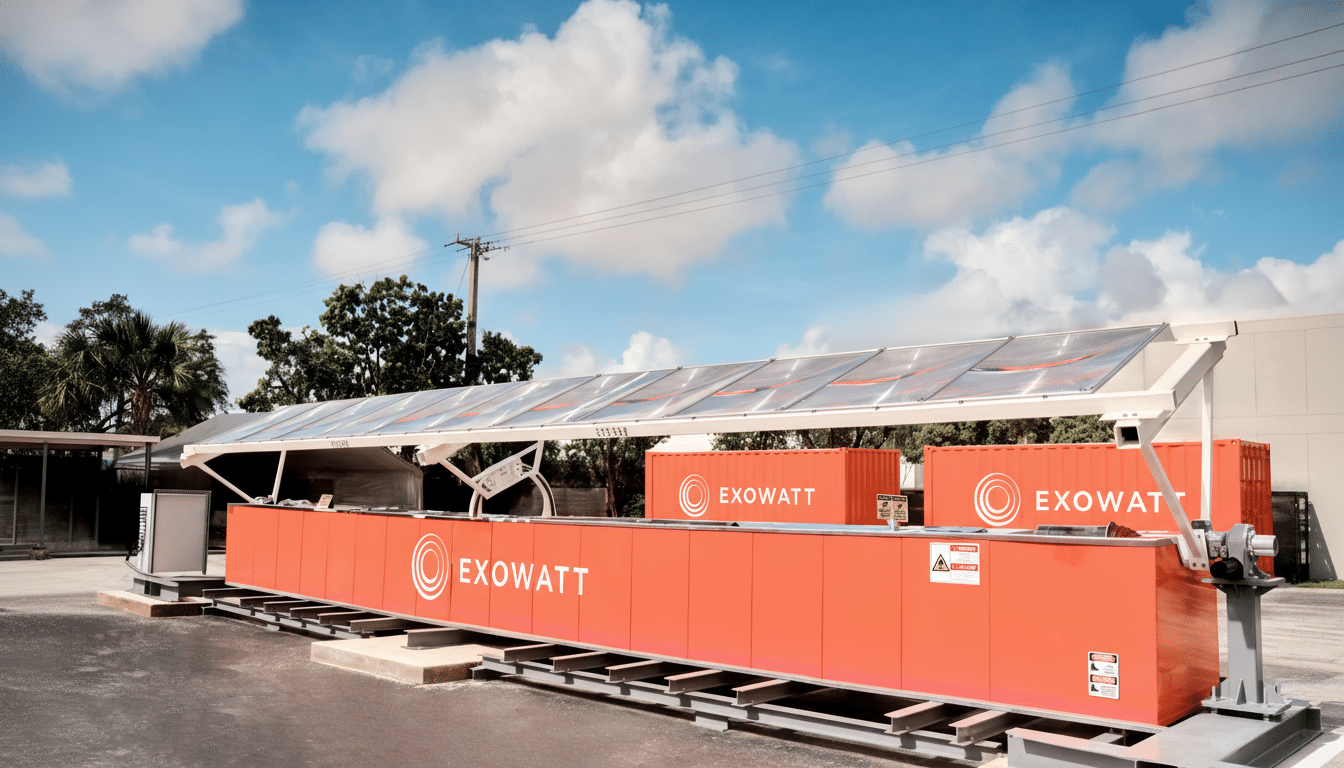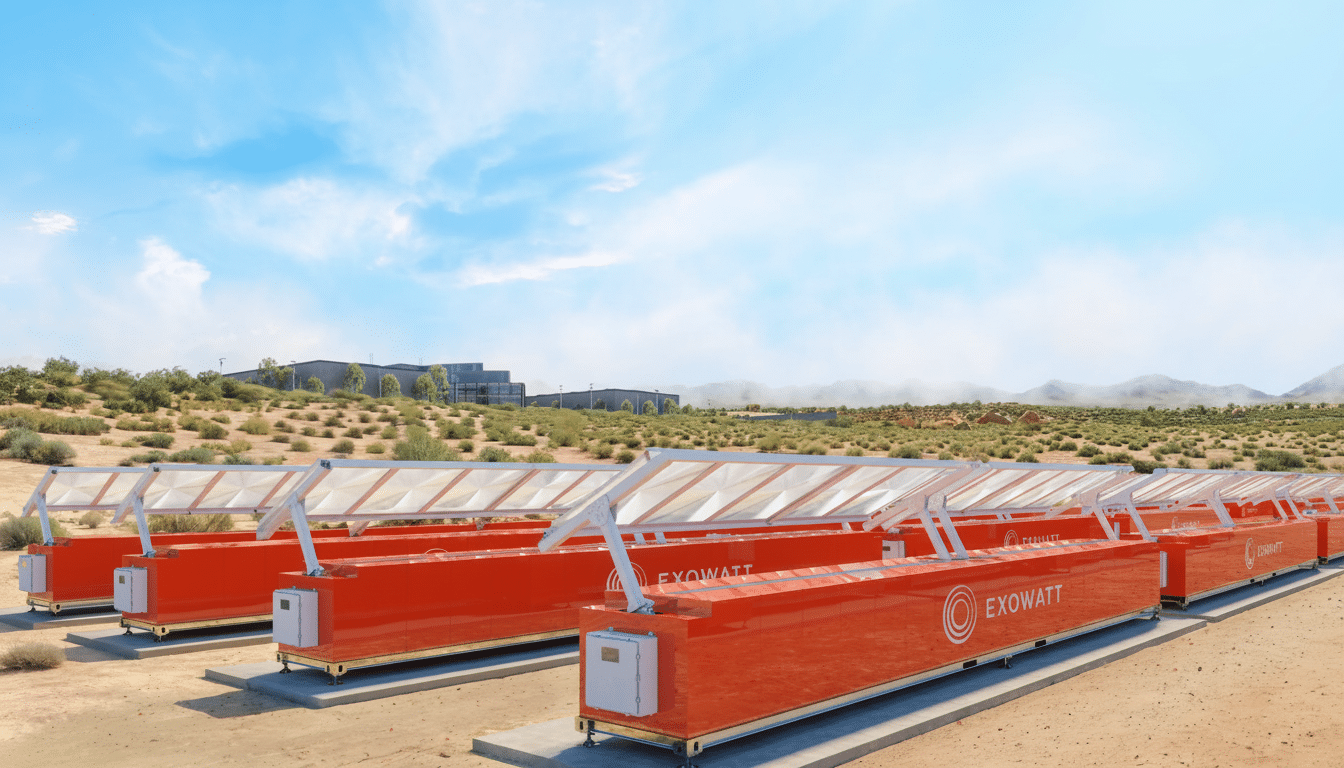Loaded with cash from Sam Altman and other blue-chip investors, Exowatt is wagering that “billions of hot rocks” can solve one of AI’s most vexing problems: a riptide of electricity demand growing faster than grid upgrades and clean power supply. The startup’s modular thermal systems are designed to provide round-the-clock, low-cost electricity beside data centers, and it aims for a striking cost goal of approximately one cent per kilowatt-hour at scale.
The pitch is simple, if brazen. Rather than construct another vast solar farm next to another separate battery, Exowatt packages concentrated solar thermal collection, heat storage and power generation into units the size of a shipping container that can be stacked by the thousands behind the fence around an AI campus.
- How the Hot Rock Modules Work to Deliver On-Site Power
- AI’s Growing Hunger for Reliable, Utility-Scale Clean Power
- Scale Economics and a Big Manufacturing Bet
- Tough Truths of Land, Sun Exposure, Maintenance, and Uptime
- A Crowded Field With a Troubled Past in Solar Thermal
- What Will Prove the Concept for Exowatt’s Thermal Approach

How the Hot Rock Modules Work to Deliver On-Site Power
Every Exowatt P3 looks like a metal container with lenses jutting out that focus sunlight into a beam. Those burners heat specially engineered bricks (dense, refractory “rocks,” really) that store the energy for future consumption. When electricity is required, a controlled airstream transfers the heat to a Stirling engine driving a generator.
Each thermal battery can hold useful heat for up to five days, the company says, allowing for overnight and multiday dispatch with no requirement for external fuel. Customers daisy-chain units to reach the desired output, pairing numerous storage boxes with one generator, or several engines if power output and ramp rate is required.
Exowatt’s approach is equivalent in efficiency to photovoltaic solar and fractionally superior to PV combined with lithium-ion on overall system performance of 24/7 supply. Importantly, it is projected to be manufacturable. The hardware is purposefully understated — mirrors or lenses, heat bricks, fans and a tried-and-true heat engine — so costs can drop with scale.
AI’s Growing Hunger for Reliable, Utility-Scale Clean Power
Training and deploying large AI models are already nudging individual campuses toward the low hundreds of megawatts. The International Energy Agency estimates that global data center electricity consumption could nearly double through the middle of this decade, potentially rivaling the energy use of a large industrialized nation. And yet interconnection backlogs are enormous; Lawrence Berkeley National Laboratory estimates that more than 2,500 gigawatts of projects are lodged at the queues waiting for grid upgrades and permits.
On-site dispatchable power is an ever-more attractive proposition for hyperscalers dedicated to 24/7 carbon-free energy. Assuming that Exowatt’s thermal storage can be manufactured en masse, and located near racks where it might offer a renewable bridge to firm supply that scales with AI clusters and not with the grid.
Scale Economics and a Big Manufacturing Bet
Exowatt claimed its backlog is about 10 million P3 units, corresponding to some 90 GWh of thermal energy storage capacity. The company says it can reach the $0.01/kWh mark if it produces around a million units annually, relying on learning-curve effects that have revolutionized other energy technologies.

That thesis echoes solar’s history. The result is that the world now produces some 1.5 billion photovoltaic panels a year, their cost plunging as factories repeated the same product on an epic scale. It’s the repeatability part of it that Exowatt intends to unlock in solar thermal as well, a sector which historically had been one that was more bespoke and project-driven rather than product-driven.
The company most recently extended its round, with MVP Ventures and 8090 Industries joining earlier investors Andreessen Horowitz and Sam Altman. The capital is being used for production expansion, supplier tooling and early deployments with data center partners, according to people familiar with the plans.
Tough Truths of Land, Sun Exposure, Maintenance, and Uptime
High-irradiance areas are home to advantaged concentrated solar. In other words, the best economics for Exowatt will be in sunny areas, which limits siting and could take significant land to serve multi-hundred-megawatt loads. Dust, dirt and mirror realignment over time can detract from performance if maintenance is not carried out.
One benefit, however, is that Stirling engines are closed-cycle and air-cooled, and can consequently minimize water use — a potentially helpful feature in (many AI campuses’) arid climate, he added. But data center operators are going to expect availability levels close to utility-grade standards, so performance guarantees, redundancy strategies and fast swap-out of modular components will be the make or break for bankability.
A Crowded Field With a Troubled Past in Solar Thermal
Concentrated solar power has had trouble competing with PV and lithium-ion, too. IRENA sees a little more than 100 CSP plants globally, and showcase projects such as Nevada’s Crescent Dunes have been retired over reliability. That track record is why Exowatt’s product-over-project approach matters — standardized modules can iterate faster than custom mega-projects.
Exowatt is not the only thermal storage game in town. Rondo Energy and Antora Energy are commercializing high-temperature brick and graphite batteries charged with electricity, while Malta and Heliogen follow other heat and conversion pathways. Lazard’s most recent Levelized Cost of Energy analysis continues to show that PV and wind (whose forecasts are for the lowest cost) sit at the bottom end of the supply curve, with storage lifting all-in prices — a reminder also of how difficult it will be to deliver $0.01/kWh without heroic manufacturing gains.
What Will Prove the Concept for Exowatt’s Thermal Approach
Near term milestones are obvious: multi-month pilots delivering firm power to live compute clusters, third-party verification of capacity factor and heat retention over many cycles, and demonstration that field maintenance is as easy at thousands of units as it is in individual machines. If Exowatt can check off those boxes while driving factory learning, hot rocks could emerge as a legitimate contender for AI power — and a new chapter in the story of solar thermal.

